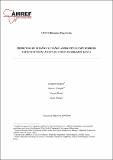| dc.contributor.author | Nyagero, Josephat | |
| dc.contributor.author | Wangila, Samwel | |
| dc.contributor.author | Kutai, Vincent | |
| dc.contributor.author | Olang, Susan | |
| dc.date.accessioned | 2022-02-24T08:56:52Z | |
| dc.date.available | 2022-02-24T08:56:52Z | |
| dc.date.issued | 2010 | |
| dc.identifier.citation | Nyagero, J., Wangila, S., Kutai, V., & Olango, S. (2010). Predictors of Behaviour Change Among Female Sex Workers Participating in AMREF's Maanisha Programme, Kenya. African Medical and Research Foundation (AMREF). | en_US |
| dc.identifier.uri | https://repository.amref.ac.ke/handle/123456789/589 | |
| dc.description | The publishers will gladly consider any request for permission to reproduce part or the whole of
this publication with the intention of increasing its availability to those who need it. AMREF
welcomes enquiries from individuals or organisations wishing to use the content for noncommercial
purposes. The organisation would also be grateful to learn how you are using this
publication and welcomes constructive comments and suggestions | en_US |
| dc.description.abstract | HIV prevention remains one of the most efficacious strategies for tackling the pandemic,
especially owing to the fact that there is still no known cure for AIDS. Initiatives aimed at
targeting most-at-risk populations (MARPS) such as commercial sex workers are key in arresting
the transmission of HIV among the general population. The purpose of this paper was to
understand the predictors of behaviour change among female sex workers participating in the
Maanisha Programme through CSOs in Kenya.
This was a cross-sectional study conducted between June and July 2010 in Western and Nyanza
provinces. Snowball sampling was used to contact and interview 156 female sex workers.
Additionally, six focus group discussions for FSWs were conducted. Binary logistic regression
was used to analyse the quantitative data. Qualitative data was categorised and summarised
thematically.
Results revealed 59.1% of the FSWs had undergone behaviour change. The multivariate
regression model found that good behaviour change was associated with the level of education
(p=0.035, adj. OR 2.23, CI=1.06-4.69), religious affiliation (p=0.001, adj. OR=4.61, CI=1.95-
13.16), number of years involved in sex work (p=0.025, adj. OR 2.36, CI=1.12-5.00), and
knowledge on prevention of HIV (p=0.020, adj. OR 4.37, CI=1.26-15.11). Engagement in
alternative income generating activities (IGAs) was almost statistically significant (P=0.054, adj.
OR=2.30, CI=0.98-5.38).
Re-orientation of the peer education programme to focus on HIV preventive measures beyond
use of condoms is recommended. The Maanisha Programme should initiate distribution of
female condoms. This will enhance the female sex workers’ ability to ensure safer sex.
Prevention of re-infection by integrating treatment and adherence into the programme will
strengthen prevention among those already infected. A strengthened access to alternative sources
of income is likely to result in positive behaviour change among FSWs in the Maanisha
Programme. | en_US |
| dc.description.sponsorship | Sida and DfID | en_US |
| dc.language.iso | en | en_US |
| dc.publisher | The Africa Medical & Research Foundation | en_US |
| dc.subject | Maanisha | en_US |
| dc.subject | HIV | en_US |
| dc.subject | AIDS | en_US |
| dc.subject | Female sex worker | en_US |
| dc.subject | Commercial sex workers | en_US |
| dc.subject | Truck Drivers | en_US |
| dc.title | Discussion Paper No. 009/2010 - Predictors of Behaviour Change among Female Sex Workers Participating in Amref’s Maanisha Programme, Kenya | en_US |
| dc.type | Other | en_US |

